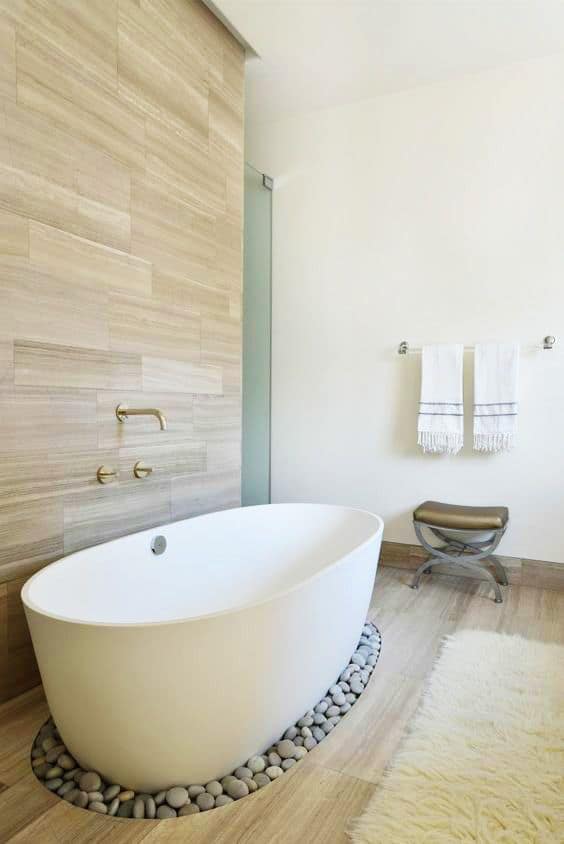Picture this: you’re envisioning your dream bathroom. A space that’s both stylish and practical, a haven of relaxation and rejuvenation. You’ve got the perfect bathtub, sleek fixtures, and beautiful tile accents. But what about the flooring? Can you use vinyl in a bathroom, a space known for its constant exposure to water?

Image: www.metallicepoxy.sg
That, my friend, is the question we’ll explore today. Vinyl flooring, with its affordability, durability, and diverse styles, has become a popular choice for many homeowners. But is it suitable for the challenges of a bathroom environment? Let’s dive in and uncover the truth about vinyl flooring in bathrooms.
Understanding the Challenges of Bathroom Flooring
Bathrooms present a unique set of challenges for flooring. Moisture is the biggest culprit – from splashes during showers to lingering condensation, water is always present. This leads to concerns about:
- Water Damage: Constant exposure to moisture can cause wood, laminate, and even some tile types to warp, rot, and mold.
- Slip and Fall Risks: Wet floors can become incredibly slippery, increasing the risk of accidents, especially for seniors and young children.
- Hygiene: Bacteria and mold thrive in damp environments, so keeping floors clean and sanitized is crucial for a healthy bathroom.
What Makes Vinyl Flooring a Good Option for Bathrooms?
So, with all these challenges, can vinyl flooring stand up to the demands of a bathroom? Here’s where things get exciting. Vinyl flooring has several features that make it a viable option for this moisture-prone space:
- Water Resistance: Vinyl flooring is made from a non-porous material. This means it doesn’t absorb water like wood or laminate, making it less susceptible to water damage and mold growth.
- Durability: Vinyl flooring is renowned for its toughness. It can withstand heavy foot traffic, scratches, and the wear and tear that comes with daily bathroom use.
- Easy Cleaning: Vinyl flooring is incredibly easy to clean. Spills and messes wipe up quickly with a damp mop, maintaining hygiene and preventing the buildup of dirt and grime.
- Style Variety: Vinyl flooring comes in a wide array of colors, patterns, and textures, mimicking the look of natural materials like wood, stone, and tile. This allows you to achieve a desired aesthetic without sacrificing practicality.
Beyond Water Resistance: Exploring the Types of Vinyl Flooring
Now, not all vinyl flooring is created equal. There are different types specifically designed for bathroom use, each with its unique features:
- Luxury Vinyl Tile (LVP): These are individual tiles that offer a realistic wood or stone look. LVP is highly durable, easy to install, and can be used in kitchens, bathrooms, and other high-traffic areas.
- Luxury Vinyl Plank (LVP): Similar to LVP but comes in planks, mimicking long strips of wood. Like LVP, it provides a beautiful and practical solution for bathrooms.
- Sheet Vinyl: This is a single, large sheet of vinyl flooring that is glued down. It’s often known for its affordability and is a good choice for smaller bathrooms.
- Vinyl Plank Tile (VPT): This combines the durability of vinyl with the look and feel of tile. VPT is a good option for areas where you need a water-resistant and stylish floor.

Image: www.whatisvinyl.com
Important Considerations: Choosing the Right Vinyl for Your Bathroom
While vinyl flooring can be a great option for your bathroom, there are a few key factors to consider:
- Moisture Resistance: Make sure the vinyl flooring you choose is specifically designed for wet areas. Look for labels like “waterproof” or “water-resistant.”
- Slip Resistance: One of the biggest concerns in a bathroom is slipperiness. Choose vinyl flooring with a textured surface for improved traction, especially in areas near the shower or tub.
- Durability: Since bathrooms experience foot traffic and spills, select a vinyl flooring with a high wear layer for lasting beauty and performance.
- Maintenance: Even though vinyl flooring is easy to clean, it’s crucial to follow manufacturer instructions for maintenance to ensure its longevity.
Expert Tips for Maintaining Your Vinyl Bathroom Floors
To keep your vinyl bathroom floors sparkling clean and looking their best, follow these expert tips:
- Regular Sweeping and Mopping: Sweep or vacuum your floors regularly to remove dirt and debris.
- Mild Cleaning Solutions: Use a mild cleaner that’s specifically designed for vinyl flooring to avoid damaging the surface. Avoid abrasive cleaners or harsh chemicals.
- Protect From Sharp Objects: Be cautious of sharp objects that can scratch or damage the vinyl surface.
- Use Rugs: Placing rugs in front of the shower or tub can reduce the risk of slipping and protect your floors from water splashes.
Can I Use Vinyl Flooring In A Bathroom
The Final Verdict: Vinyl Flooring Can Be a Smart Choice for Your Bathroom
With its water resistance, durability, and stylish options, vinyl flooring can indeed be a smart choice for your bathroom. Choose the right type of vinyl, pay attention to its slip resistance, and maintain it properly, and you’ll enjoy a beautiful, functional, and long-lasting floor that can enhance your bathroom’s overall ambiance. So go ahead, embrace vinyl, and create the bathroom haven of your dreams!






